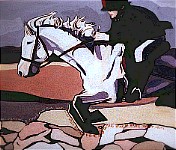 |  |  |  |  |   |
|
Mosaic Realism Fragmentation is as old as Cubism and as contemporary as sampling and sound bytes. My own mosaic view began as a child, cutting out images and phrases from magazines. As I glued the out-of-context fragments onto blank pages, I created new stories from the stash, finding a common theme among the pieces or timing an unexpected twist to be found by the viewer only after the turn of a page. Deconstruct - Reconstruct Sitting at the controls of the family stereo, I listened to radio stations, ready to record voice fragments from DJs, newscasters, and other radio personalities. With no chance to re-edit the recordings, I carefully anticipated short pieces I could string together, weaving a type of creative non-fiction, looking for a through-line in the random quotes. Multiple Viewpoints I pieced together an education in visual and written communication at 5 different schools and came to believe in a mosaic realism. The parts of the whole can shift. The point of focus can change. A buried layer can surface. The pattern can be altered. Every image is incomplete. We never get the whole story, ever. So, I keep asking, "What is the viewing point at the moment? What parts of the whole are currently out-of-focus? What is in the peripheral of the current perspective? What is missing?" Added Layers
Shuffled Images Then I started cutting up and shuffling images I drew. As I hung up my first attempt, I noticed that it resembled a woman's face stuck in the squares of a patchwork quilt. After reading a 1998 Newsweek article about the women wearing burkas in Afghanistan, I went back to the quilt woman and wrote on her, "woman stuck in the fabric of society." Pieces of the Whole To what degree can the parts of everything around us ... society, culture, individuals ... be reshuffled like a deck of cards, edited likes squares of film footage? Can art represent this ever-present possibility to shift? I've been exploring this question.
|
